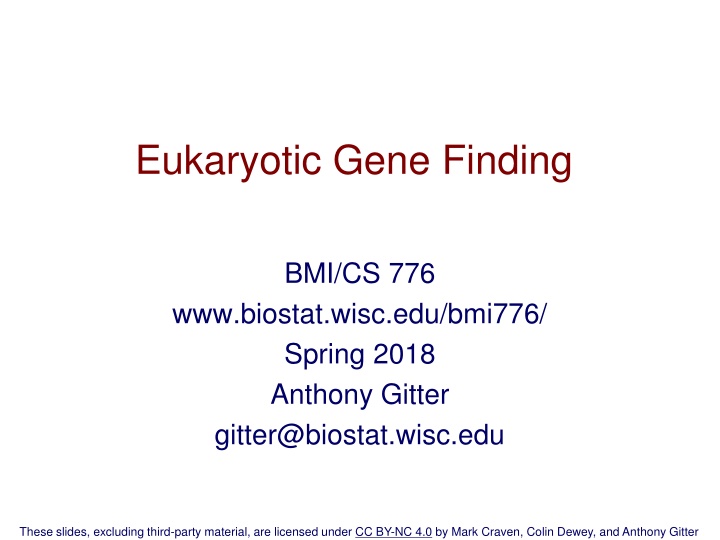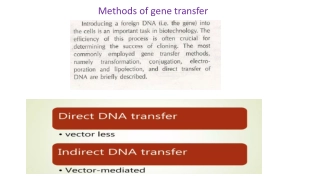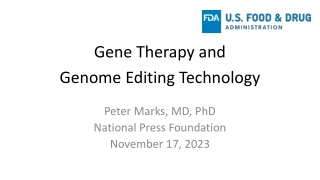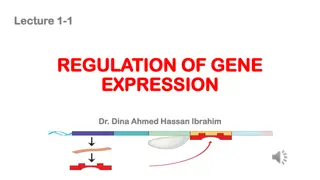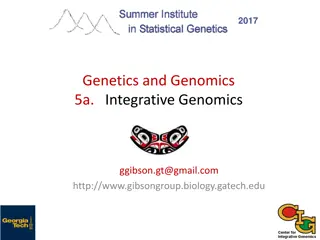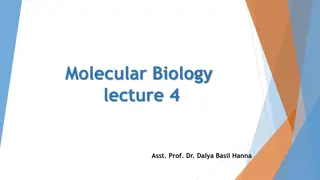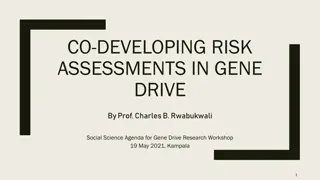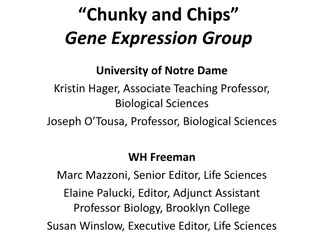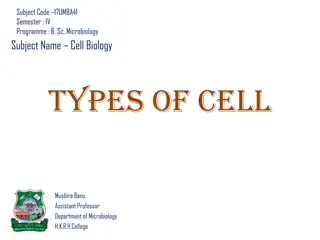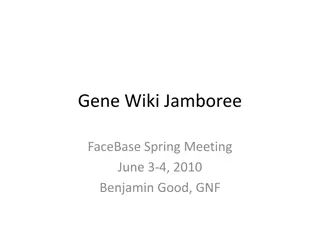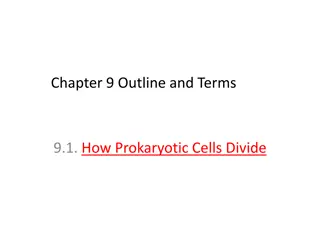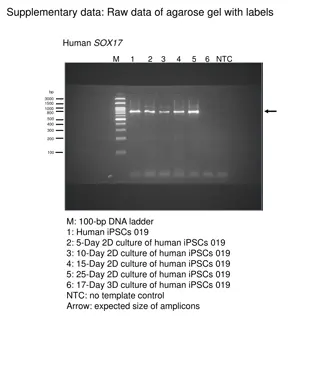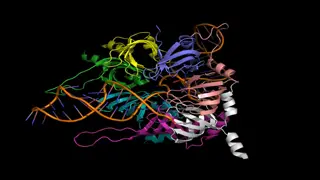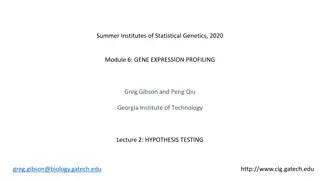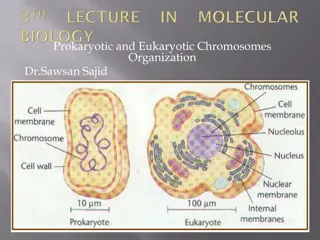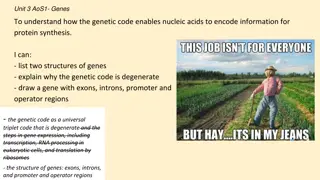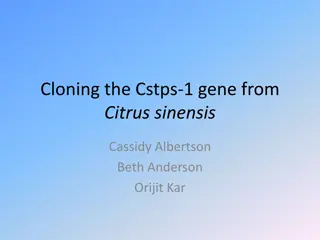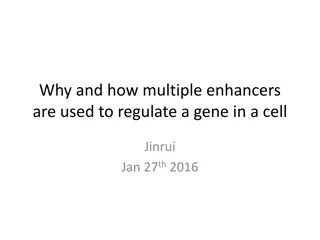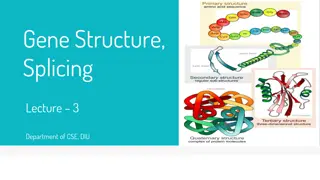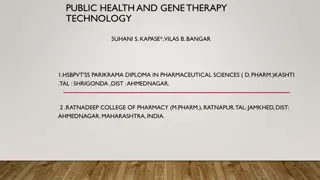Eukaryotic Gene Finding
Examining the process of eukaryotic gene finding through the incorporation of sequence signals using Hidden Markov Models (HMMs). Explore concepts like modeling durations, conservation across sequences, and modern gene finding approaches.
Uploaded on Feb 17, 2025 | 3 Views
Download Presentation

Please find below an Image/Link to download the presentation.
The content on the website is provided AS IS for your information and personal use only. It may not be sold, licensed, or shared on other websites without obtaining consent from the author.If you encounter any issues during the download, it is possible that the publisher has removed the file from their server.
You are allowed to download the files provided on this website for personal or commercial use, subject to the condition that they are used lawfully. All files are the property of their respective owners.
The content on the website is provided AS IS for your information and personal use only. It may not be sold, licensed, or shared on other websites without obtaining consent from the author.
E N D
Presentation Transcript
Eukaryotic Gene Finding BMI/CS 776 www.biostat.wisc.edu/bmi776/ Spring 2018 Anthony Gitter gitter@biostat.wisc.edu These slides, excluding third-party material, are licensed under CC BY-NC 4.0 by Mark Craven, Colin Dewey, and Anthony Gitter
Goals for Lecture Key concepts Incorporating sequence signals into gene finding with HMMs Modeling durations with generalized HMMs Modeling conversation with pair HMMs Modern gene finding and genome annotation 2
Sources of Evidence for Gene Finding Signals: the sequence signals (e.g. splice junctions) involved in gene expression Content: statistical properties that distinguish protein-coding DNA from non-coding DNA Conservation: signal and content properties that are conserved across related sequences (e.g. orthologous regions of the mouse and human genome) 3
Splice Signals Example donor sites acceptor sites -3 -2 -1 1 2 3 4 5 6 Figures from Yi Xing exon exon There are significant dependencies among non-adjacent positions in donor splice signals Informative for inferring hidden state of HMM 5
Parsing a DNA Sequence The HMM Viterbi path represents a parse of a given sequence, predicts exons, acceptor sites, introns, etc. Hidden state Intergenic 5 UTR Exon Intron Observed sequence ACCGTTACGTGTCATTCTACGTGATCATCGGATCCTAGAATCATCGATCCGTGCGATCGATCGGATTAGCTAGCTTAGCTAGGA ACCGTTACGTGTCATTCTACGTGATCATCGGATCCTAGAATCATCGATCCGTGCGATCGATCGGATTAGCTAGCTTAGCTAGGA How can we properly model the transitions from one state to another? 6
Length Distributions of Introns/Exons Introns Initial exons Figure from Burge & Karlin, Journal of Molecular Biology, 1997 geometric dist. provides good fit Internal exons Terminal exons geometric dist. provides poor fit 7
Duration Modeling in HMMs Semi-Markov models are well-motivated for some sequence elements (e.g. exons) Semi-Markov: explicitly model length duration of hidden states Also called generalized hidden Markov model 8
The GENSCAN HMM for Eukaryotic Gene Finding [Burge & Karlin 97] Figure from Burge & Karlin, Journal of Molecular Biology, 1997 Each shape represents a functional unit of a gene or genomic region Pairs of intron/exon units represent the different ways an intron can interrupt a coding sequence (after 1st base in codon, after 2nd base or after 3rd base) Complementary submodel (not shown) detects genes on opposite DNA strand 9
Parsing a DNA Sequence The Viterbi path represents a parse of a given sequence, predicting exons, introns, etc. ACCGTTACGTGTCATTCTACGTGATCATCGGATCCTAGAATCATCGATCCGTGCGATCGATCGGATTAGCTAGCTTAGCTAGGAGAGCATCGATCGGATCGAGGAGGAGCCTATATAAATCAA ACCGTTACGTGTCATTCTACGTGATCATCGGATCCTAGAATCATCGATCCGTGCGATCGATCGGATTAGCTAGCTTAGCTAGGA GAGCATCGATCGGATCGAGGAGGAGCCTATATAAATCAA 10
Comparative Algorithms Genes are among the most conserved elements in the genome use conservation to help infer locations of genes Some signals associated with genes are short and occur frequently in the genome use conservation to eliminate false candidate sites from consideration 11
Pair Hidden Markov Models Each non-silent state emits one or a pair of characters Transition probabilities H: homology (match) state I: insert state D: delete state 12
Pair HMM Paths are Alignments sequence 1: AAGCGC sequence 2: ATGTC B H A A H A T I G I C H G G D H C C E hidden: observed: T 13
Generalized Pair HMMs Represent a parse , as a sequence of states and a sequence of associated lengths for each input sequence sequence of hidden states = { , , , } q q q n q N P+ F+ Einit+ 1 2 = { , , , } d d d n d 1 2 = { , , , } e e e ne 1 2 pair of sequences generated by hidden state may be gaps in the sequences pair of duration times generated by hidden state SLAM: Pachter et al. RECOMB 2001 14
Modern Genome Annotation RNA-Seq, mass spectrometry, and other technologies provide powerful information for genome annotation 15
Modern Genome Annotation Yandell et al. Nature Reviews Genetics 2012 16
Modern Genome Annotation protein-coding genes, isoforms, translated regions small RNAs long non-coding RNAs promoters and enhancers pseudogenes Mudge and Harrow Nature Reviews Genetics 2016 17
